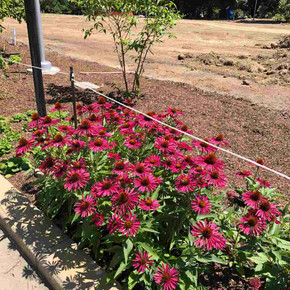
Echinacea x hybrid 'Pretty Parasols' - CONEFLOWER 'PRETTY PARASOLS'
Charming, large bi-color coneflower hybrid. Tall and upright with very sturdy stems. Floriferous and long blooming period, with good drought tolerance. Drooping petals, whitish with magenta-pink halo and orange centers. Prolonged healthy leaves. Reminicent of Echinacea pallida, but this coneflower gets bigger and stronger at the base.
Flowers don't bloom in the same height, so the plant looks very natural (unlike most of the newest compact hybrids)
'Pretty Parasols' can remind of other cultivars like ‘Fountain Pink Eye’ and ‘Pink Tip’.
Blooming Time: July till October
Size: clumps about 30-36" tall x 20" wide
USDA Zones: 4 to 9
Culture: full sun to filtered sun, adaptable to many soil types (including acidic, alkaline or clayish)
Moisture Needs: medium (average) to medium-dry or drier, tolerates poor soils.
Origin: Garden origin hybrid discovered by famous plant person Jan Spruyt from Belgium. Chance seedling were discovered in the coneflower field in 2013 (Buggenhout, Belgium). Originally the plants was named ‘JS Engeltje’ (with Jan Spruyt initials), later changed to 'Pretty Parasols'. Parentage of this plant is unknown. But it probably carries genes of Echinacea pallida - due to the more narrow leaves, drooping petals, longevity and drought tolerance. In Belgian conditions (milder temperate climate) was proven with high endurance to wind, cold, heat and sun. We dodn't trial this plant here yet, but we believe it is a good plant even in Midwestern conditions. 'Pretty Parasols' was patented in 2020 under PP31675 (unlicensed propagation is prohibited). Plants are propagated vegetatively from tissue culture.
Black Walnut Tolerant: yes
Deer/Rabbit Resistant: yes / yes
Attracts Butterflies or Pollinators: yes / yes
Attracts Hummingbirds: yes
Pot Size: square 3.5" x 4" deep perennial pot
Plant Combinations: Good with Achillea, Agastache, Amsonia, summer blooming Allium, Asclepias tuberosa, Aster, Baptisia, Calamintha, Coreopsis, other Echinacea, Gaura, Hemerocallis, Iris x barbata (I. x gemanica), Knautia, Liatris, Monarda, Nepeta, Oenothera, Penstemons, Platycodon (taller ones), Rudbeckia, Salvia nemorosa hybrids, tall Sedum, Solidago, Stachys, Vernonia lettermannii, taller Veronica, Yucca, and grasses like Bouteloa, Muhlenbergia, Sporobolus, Schizachyrium scoparium, Sorghastrum or Panicum.
Picture Copyright: Concept Plants

Echinacea x hybrid 'Pretty Parasols' - CONEFLOWER 'PRETTY PARASOLS'
Charming, large bi-color coneflower hybrid. Tall and upright with very sturdy stems. Floriferous and long blooming period, with good drought tolerance. Drooping petals, whitish with magenta-pink halo and orange centers. Prolonged healthy leaves. Reminicent of Echinacea pallida, but this coneflower gets bigger and stronger at the base.
Flowers don't bloom in the same height, so the plant looks very natural (unlike most of the newest compact hybrids)
'Pretty Parasols' can remind of other cultivars like ‘Fountain Pink Eye’ and ‘Pink Tip’.
Blooming Time: July till October
Size: clumps about 30-36" tall x 20" wide
USDA Zones: 4 to 9
Culture: full sun to filtered sun, adaptable to many soil types (including acidic, alkaline or clayish)
Moisture Needs: medium (average) to medium-dry or drier, tolerates poor soils.
Origin: Garden origin hybrid discovered by famous plant person Jan Spruyt from Belgium. Chance seedling were discovered in the coneflower field in 2013 (Buggenhout, Belgium). Originally the plants was named ‘JS Engeltje’ (with Jan Spruyt initials), later changed to 'Pretty Parasols'. Parentage of this plant is unknown. But it probably carries genes of Echinacea pallida - due to the more narrow leaves, drooping petals, longevity and drought tolerance. In Belgian conditions (milder temperate climate) was proven with high endurance to wind, cold, heat and sun. We dodn't trial this plant here yet, but we believe it is a good plant even in Midwestern conditions. 'Pretty Parasols' was patented in 2020 under PP31675 (unlicensed propagation is prohibited). Plants are propagated vegetatively from tissue culture.
Black Walnut Tolerant: yes
Deer/Rabbit Resistant: yes / yes
Attracts Butterflies or Pollinators: yes / yes
Attracts Hummingbirds: yes
Pot Size: square 3.5" x 4" deep perennial pot
Plant Combinations: Good with Achillea, Agastache, Amsonia, summer blooming Allium, Asclepias tuberosa, Aster, Baptisia, Calamintha, Coreopsis, other Echinacea, Gaura, Hemerocallis, Iris x barbata (I. x gemanica), Knautia, Liatris, Monarda, Nepeta, Oenothera, Penstemons, Platycodon (taller ones), Rudbeckia, Salvia nemorosa hybrids, tall Sedum, Solidago, Stachys, Vernonia lettermannii, taller Veronica, Yucca, and grasses like Bouteloa, Muhlenbergia, Sporobolus, Schizachyrium scoparium, Sorghastrum or Panicum.
Picture Copyright: Concept Plants
Customer Reviews
-
Very nice!
This is a really nice healthy plant with great roots and foliage. It’s just like everything US PERENNIALS sends me with their fast service… Excellent plants that are ready to plant and grow like crazy. I adore US PERENNIALS!!!?
-
Nice
Healthy good sized plants arrived nicely packaged and on time. Could not ask for more.
-
Lovely and different!
This one is tall! At first it looked like just a white coneflower but the pink emerged slowly around the central cone, giving it a romantic look. It is tall but sturdy - you may want to plant it below a deck so that you can look down on it to see more of the pink but yes, it does bloom at different heights, giving it a natural look. I want more!!!






